#arctic seed vault
Explore tagged Tumblr posts
Text
The Arctic Seed Vault Shows the Flawed Logic of Climate Adaptation
https://www.scientificamerican.com/article/the-arctic-seed-vault-shows-the-flawed-logic-of-climate-adaptation/
#arctic seed vault#arctic#seed vault#seed#vault#flawed#logic#climate adaptation#climate change#climate crisis#climate action#climate justice#climate solutions#ausgov#politas#auspol#tasgov#taspol#australia#fuck neoliberals#neoliberal capitalism#anthony albanese#albanese government
1 note
·
View note
Text
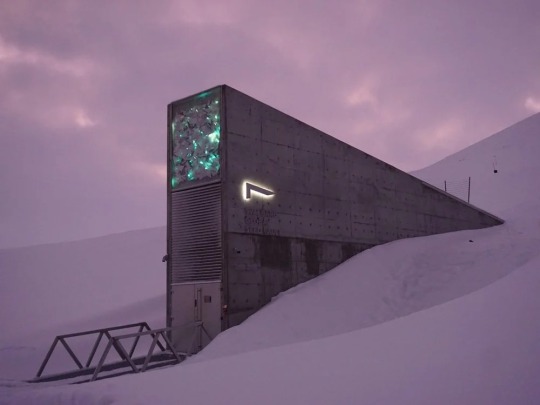
The Svalbard Global Seed Vault is located in the Norwegian Arctic on the remote island of Spitsbergen. Shaliz Barzani/Crop Trust
Take a Virtual Tour of the ‘Doomsday’ Seed Vault! The Impressive Depository Carefully Preserves Over One Million Seed Samples In Its Arctic Location
— Teresa Nowakowski, Staff Contributor | March 16, 2023 | Smithsonian Mag
In the frigid Norwegian Arctic, a gray wedge-shaped building protrudes from a mountain. Snow blows across the small metal bridge that leads to its entrance, above which a pattern of steel, mirrors and prisms reflect a ghostly green light. Large letters on the building’s side hint at the precious collection that’s held within, declaring that here is the entrance to the “Svalbard Global Seed Vault.”
Only a handful of people are allowed inside the vault, and its five metal doors are only opened a few times each year for new entries of seeds. But now, in honor of its 15th anniversary, you can catch a rare glimpse of the vault’s interior through a virtual tour.
Carved into Plateau Mountain on the Norwegian island of Spitsbergen, it holds more than 1.2 million seed samples from almost every country in the world, including recent first-time depositors Albania, Croatia, North Macedonia and Benin. Meant to protect crop biodiversity in case of localized catastrophe, this curious depository is often referred to as the “doomsday seed vault.”
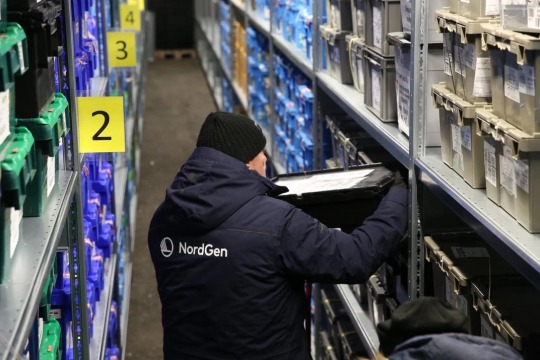
A member of NordGen, the gene bank of the Nordic countries, places a box of seeds in one of the vault chambers. Luis Salazar/Crop Trust
“From here in Svalbard, the world looks different. This seed vault represents hope, unity and security,” says Stefan Schmitz, executive director of the Crop Trust, a co-manager of the vault, in a press release. “In a world where the climate crisis, biodiversity loss, natural catastrophes and conflicts increasingly destabilize our food systems, it has never been more important to prioritize safeguarding these tiny seeds that hold so much potential to adapt our future food to such global threats.”
The contents of this doomsday vault are effectively backup storage for a global network of more than 1,700 smaller vaults called gene banks. Countries deposit copies of the seeds they hold in their own banks, and the Svalbard facility keeps them safe. This year, new seed deposits of wild strawberries, wheat, maize and rice have joined the ranks of other preserved plants. An organization from North Macedonia deposited seeds from an ajvarka red pepper variety used to make a popular traditional relish.
The seeds remain the property of the depositing country, to be withdrawn in the event their own stockpile is compromised. In 2015, for example, seeds from the vault were used to restart the International Center for Agricultural Research in the Dry Areas after its Aleppo seed bank had to be abandoned during the Syrian civil war.
To preserve its contents, the Arctic vault is protected by almost 400 feet of rock at its deepest point. Even virtually, its floor-to-ceiling shelves with the space for thousands of seed boxes are an impressive sight to behold.
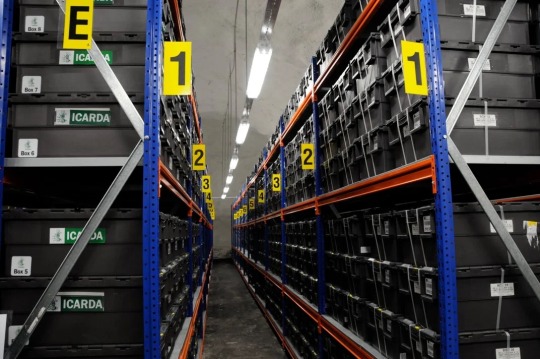
Shelves inside one of the seed vault's three chambers, each of which are capable of storing 3,000 samples. Mari Tefre/Global Crop Diversity Trust
“It is a bit like being in a cathedral. It has high ceilings and when you’re standing inside the mountain, there’s hardly any sound. All you can hear is yourself,” Lise Lykke Steffensen, executive director of NordGen, the gene bank of the Nordic countries that handles day-to-day operation of the vault, tells the Guardian’s Patrick Greenfield. “When you open the door, it’s minus 18 degrees Celsius—the international standard for conserving seeds—which is very, very cold. Then you see all of the boxes with seeds from all of these countries. I’ve been so many times and I’m still curious.”
Since its establishment in 2008, the vault’s collection has continued to grow. It is the largest global security reserve of seeds for food and feed crops, according to the Norwegian government.
In a tumultuous world where wars and extreme weather events wreak havoc, those who run the vault say it’s an important symbol of cooperation and global community.
“The seeds don’t care that there are North Korean seeds and South Korean seeds in the same aisle,” Brian Lainoff, the former lead partnerships coordinator of the Crop Trust, told Time’s Jennifer Duggan in 2017. “They are cold and safe up there, and that’s all that really matters.”
#The Svalbard Global Seed Vault#‘Doomsday’ Seed Vault#One Million Seed Samples#Arctic#Teresa Nowakowski#Norwegian 🇳🇴 Arctic
3 notes
·
View notes
Text
#american bison#anthropocene#arctic#australia#biodiversity#biodiversity loss#biorepository#bison#candice gaukel andrews#climate change#cryopreservation#cultures#currency#environment#global seed vault#global warming#money#moon#natural habitat adventures#nathab#nature#norway#permafrost#predators#ravens#science#science and environment#scientific research#svalbard#wild
0 notes
Text
Two men who were instrumental in creating a global seed vault designed to safeguard the world's agricultural diversity will be honoured as the 2024 World Food Prize laureates.
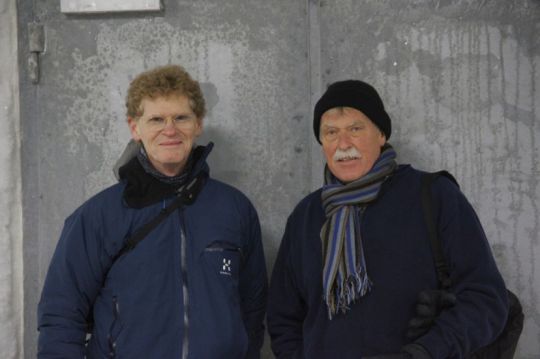
Cary Fowler, the US special envoy for Global Food Security, and Geoffrey Hawtin, an agricultural scientist from the UK and executive board member at the Global Crop Diversity Trust, will be awarded the annual prize and split a $500,000 (€464,000) award. In 2004, Fowler and Hawtin led the effort to build a backup vault of the world's crop seeds in a place where it could be safe from political upheaval and environmental changes.
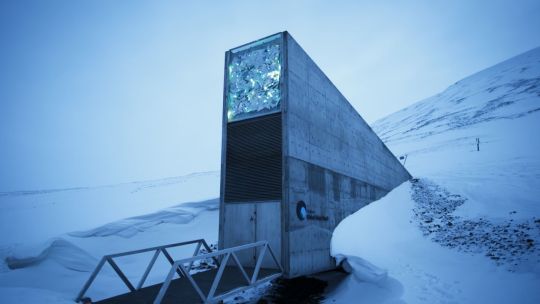
The facility was built into the side of a mountain on a Norwegian island in the Arctic Circle where temperatures could ensure seeds would be preserved.
The Svalbard Global Seed Vault - also known as the 'Doomsday vault' - opened in 2008 and now holds 1.25 million seed samples from nearly every country in the world.
#solarpunk#solar punk#indigenous knowledge#community#reculture#seed vault#svalbard#global food prize#preserving the future
158 notes
·
View notes
Note
Re: your recent post (er, reblog) of seed banking. Have you read this? Maybe it's not as great of an idea as we think? (Or maybe it's just better than nothing?)
https://www.scientificamerican.com/article/the-arctic-seed-vault-shows-the-flawed-logic-of-climate-adaptation/
I hadn't read that article before, but I've read similar critiques (perhaps with less ironic and apropos illustrations of these issues, though!) of the practice.
Generally, I think of seed-banking as I do life-support or an AED — a last ditch effort to preserve life in the future or to extend it long enough that it has a chance at recovery. I also think that, most of the time, any effort to preserve life is worthwhile and that only through a variety of tactics will we succeed.
An example of seed-banking that I believe has true potential is the seed banking of Fraxinus nigra (black/brown ash) and other ash species in the Eastern US. The crisis they are facing (the emerald ash borer beetle) is a swift and deadly one. I have watched ash stands go from apparently healthy to standing deadwood in a 5 year span or less. Given that this beetle is a novel species to this region, there is a relatively good chance that once it runs out of its host plant, it will become locally extinct. And then, perhaps, new hope will burst from those carefully saved and preserved ash samaras and ash reintroduction will begin. A grim hope for these species, but a hope nonetheless — a hope they might not otherwise have.
I re-blogged the post you reference less because I think that reviving that species is something we should be actively pursuing in the wild and more out of wonder at the enormous capacity for life and the lengths our curiousity can reach. Put an ancient seed in a hormone soup and coax it along and miracle of miracles — it lives! In a world where the study of previously extant life is limited to static and incomplete fragments, it is beyond wonder to have observations of a living specimen.
With my current level of knowledge, my stance on seed-banking overall is that it is a tool, and only a tool. It fits certain circumstances better than others. It sounds like the specific seed bank in that article is coming at the climate crisis from a more "technology will save us" attitude than I personally agree with, but I am not any more all-knowing than they are. In large part, the work we do to combat climate change is striving to preserve possibility. Seed banks are one way to do that. There is no singular, perfect tool, but that does not mean that it is useless in the broader solution.
#i hope this makes any sense whatsoevee#basically it boils down to: its complicated. and i dont really know.#but here are some thoughts and half-baked opinions#seed banking#raincoats answers#truly just the loosey-goosiest of thoughts
9 notes
·
View notes
Text
"...seeds isolated from the environment do not evolve, so if they are reintroduced decades from now, they may face a natural world to which they are no longer adapted."
#food not lawns#seed saving#seed starting#seeds#gardening#home garden#food#gardenblr#grow food#garden blog#suburban agriculture#suburban farm#farm blog#farming
9 notes
·
View notes
Link
2 notes
·
View notes
Note
Oh, hey. One of the heist dialogues has Ana, Elsie, and Osiris talking about Nefele Stronghold.
Yes! Here.
Elsie: Submind fragment compiling...
Osiris: I have seen this term more than once in the data feed. What is "Nefele Stronghold"?
Ana: That again? Ikora's spies turned up that name around the same time Mars came back, but it was scrubbed from Rasputin's archives.
Elsie: I've never heard that name either, but "stronghold" designations were only used for colonization projects, or... anti-extinction vaults.
Osiris: This is promising. Perhaps additional clues await in the information we've already collected. Someone tell Saint I'll be in my study.
Really good confirmation that "strongholds" were about colonisation projects which ties into the whole story about Soteria from the dungeon and how she ended up crashing into Neptune, which directly confirms Neomuna's creation.
Obviously, Osiris and co don't have all the same details that we do right away, which is why Osiris is informing us that he has to go to his study immediately. Essentially without the knowledge we got from the dungeon, this would still be impossible to fully confirm and also impossible for the characters in-game to understand, but with these two combined, they'll figure it out in time for Lightfall.
It's not entirely clear what "anti-extinction vault" is. My first association is the Global Seed Vault (also dubbed "doomsday vault"), a real thing that exists:
The Seed Vault provides long-term storage of duplicates of seeds conserved in genebanks around the world. This provides security of the world's food supply against the loss of seeds in genebanks due to mismanagement, accident, equipment failures, funding cuts, war, sabotage, disease and natural disasters.
Basically, it's a vault that hosts seeds of various plants from all over the world which makes sure that, in the event of any disaster of any kind which threatens to destroy the environment, we have a backup of all plants needed for food production to re-seed the planet. It's located in the Arctic to make sure that the seeds remain safely stored in the event of a catastrophic power failure; the ice would then preserve the seeds naturally.
Given that we have this now, it's not a stretch to imagine that people would do the same in the Destiny universe, especially in the Golden Age. It's basically one of the first instincts really, to make sure our knowledge is preserved for the future, in case of a disaster. This is an absolutely fascinating concept to me and one that I would fully expect for Destiny to mention in some way; humanity in Destiny was already concerned with our longterm safety and envisioned a lot of different colonisation projects that tie directly with finding a place for humans to live in should the Solar system become uninhabitable for whatever reason.
This seems to be playing with that concept. I wonder if they plan on mentioning that again.
Some non-canon stuff from my obsession with this below:
The mention of anti-extinction vaults and what they could possibly mean is also really exciting to me because I've assumed their existence... in a Destiny tabletop RP I led almost 3 years ago!
I often talk about that one niche lore mention of how Antarctica is gone in the present day of Destiny and the presumed idea that the continent was sunk in the Collapse. Well, for my Destiny RP with my friends, I wanted to explore that. I needed a reason for my players being there in the Collapse, so, inspired by the Global Seed Vault, I envisioned a similar vault being buried in Antarctic ice, but much bigger in scope.
Mine was a Braytech facility and it did not just hold seeds, but a record of all life and knowledge on Earth; genetic material of animals, seeds from plants, archives and libraries. I also connected the work of the vault to the Exodus program and had the vault equipping Exodus ships with packages of Earth life and knowledge for colonists to take into their new worlds.
My reasoning for Darkness going out of their way to completely erase the entire continent off the face of the planet is that they wanted to make sure all of our history dies with us. It knew what we had hidden there and it knew that the destruction had to be thorough.
It was a cool RP! Everybody died!
The graphics I made for the players:
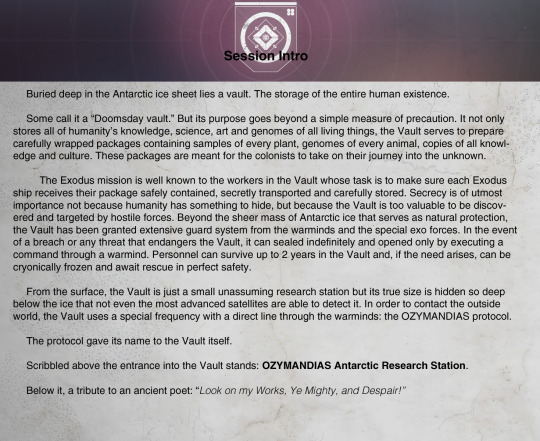
IMAGINE MY SURPRISE when Beyond Light came out 9 months after this and the missing pages from Clovis' logbook had the following:
I cannot believe that I actually find it tiring, but the sheer scale and passivity of the Vex constructs infuriates me.
Imagine stumbling upon an inscription in the desert: "I am Ozymandias, king of kings. Look upon my works. Or don't. I really don't care."
I think I also similarly lost my shit when I heard this line about anti-extinction vaults in the game. There is still time for Bungie to completely confirm a thing I invented 3 years ago as canon. This is how me getting more content about Antarctica being sank by Darkness can still win.
21 notes
·
View notes
Text
teh the the seed vault build into the (ant- ?)arctic permafrost, so it would withstand some kind of global catastrophe. and the permafrost melting bc of some kind of global catastrophe. is this art?
8 notes
·
View notes
Text
Last Monday of the Week 2023-04-03
Quilt's done, let's watch some movies.
Listening: Finished catching up to 99 percent invisible, which only took me like five years of cooking, cleaning, commuting, sewing, video gaming and soldering. Admittedly it's only about half of all of those things, but hey.
There's a lot of good 99pi episodes although a lot of them are actually guest episodes, for example Finding Julia Morgan is actually from New Angle: Voice, about an early and prolific skyscraper designer.
For originals, there's the story of the Nikolai Vavilov and the Seed Potatoes of Leningrad although frankly The Anthropocene Reviewed did it better, and there's Miss Manhattan, which is the story of a prolific model who is as a result featured in a ton of architectural work, Audrey Munson.
Reading: Started qntm's Ra, spec fic hard science fantasy where magic is a precise scientific process which is primarily best understood through careful measurement and differential equations. Appealing to me as an electrical engineer, where most things are also best understood through careful measurement and differential equations.
I read the first couple chapters ages ago but didn't stick with it, it's hard to read on a computer, I ended up buying the ebook and I'm devouring it. qntm has a way with words and worlds, and an appreciation for the power of institutional knowledge and formal theory that makes his stories feel very real and grounded. Even if they open with a drunk mage blasting some muggers with a microwave thermal lance.
Watching: Triple feature, big show today. First, episode two of Dynamo Dreams is out, only a year after the first one, not bad for what is mostly a solo VFX project. Beautiful, grungy, greebled sci-fi.
youtube
My brother called me up at six in the evening like hey do you want to go see a movie, and I almost never turn that offer down despite his incredibly terrible taste in movies and TV. We saw Shazam 2, which was mediocre in uninteresting ways. If you want to enjoy it, walk out about 15 minutes before it ends and it'll at least do something bold and thoughtful. The most I can say is that it keeps track of all it's plot points and ties them all off neatly.
Finally The Edge of Tomorrow, the time loop movie from like 2014. I like time loops, they give you a lot of room to play with. Manages to handle its stakes really well and convey the exhaustion and investment of a time loop without actually playing out every loop, which is hard. Makes me want to play Elsinore.
Playing: Nothing much, I got a couple games of Valorant in with The Buds. Now that I don't have sewing to podcast through I might go back to Forza a few hours a week. It's a reliable option. That or Warframe maybe. Needs to be a game with minimal text and little strategy.
Making: The Penrose quilt is finally done, took a few months there huh.
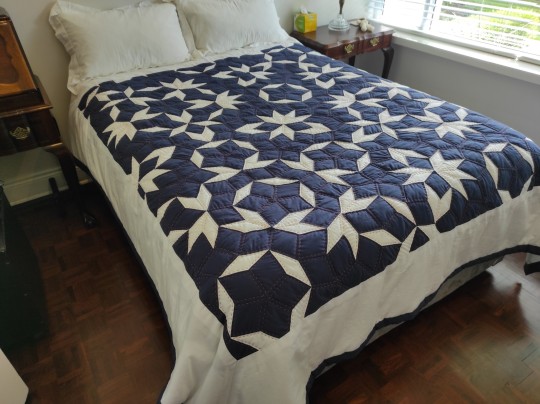
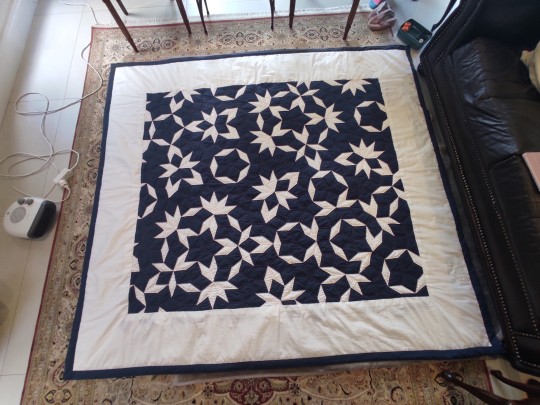
I'm really glad it's done, I'm looking forward to actually using it once I move out. Soon hopefully.
My sewing skill has really gone up over the course of this project, sometimes I'd read or watch someone's dressmaking project and I'd think there's no way you can do consistently tight backstitch by hand for that long of a seam but no, you totally can, it's not even that hard.
Tools and Equipment: If you're going to be working with Perle cotton you really want embroidery specific needles, they've got longer eyes that are better suited to the thicker floss than conventional needles.
9 notes
·
View notes
Text
Facts To Know About the Global Seed Vault
The Svalbard Global Seed Vault, also known as the "doomsday vault," is regarded as humanity's last hope against extinction following a global crisis. Though its mission is to protect the world's seeds, its creation was not intended to reseed the world after a global disaster.
Cary Fowler, a scientist, conservationist, and biodiversity advocate, created the Svalbard Global Seed Vault. Despite the fact that there are over 1,700 genebanks around the world that keep seed collections, they are all vulnerable to war, natural disasters, equipment malfunctions, and other issues. In 2003, Fowler began to imagine a backup storage facility where all of the world's seeds could be safely stored.

Fowler's vision was realized in 2008 when the Global Seed Vault was carved nearly 500 feet (152 meters) into the side of a mountain. The first withdrawal from the seed vault occurred in 2015 as a result of the Syrian war. The seeds were used to replace those that had been damaged in a gene bank near the war-torn Syrian city of Aleppo. In 2016, Fowler published the book "Seeds on Ice: Svalbard and the Global Seed Vault."
Location
The Svalbard Global Seed Bank is located in Svalbard, a Norwegian archipelago (a group of islands in the Arctic Ocean). According to the Norwegian Ministry of Agriculture and Food, Svalbard is located north of mainland Europe, halfway between continental Norway and the North Pole.
"None of these reasons for locating the facility in Norway would have sufficed had it not been for the fact that Svalbard offers almost perfect conditions: it is remote and thus safer than other possible locations, and it is naturally cold. We wanted to have a facility that would stay naturally frozen without the aid of mechanical freezing equipment. Inside the mountain in the permafrost, we get steady below-freezing temperatures. We mechanically lower the temperature further to about minus 18 C [0 F], but this is much easier to accomplish when you start at -5 C [23 F] rather than above freezing."
The Svalbard Global Seed Bank is located in Svalbard, a Norwegian archipelago (a group of islands in the Arctic Ocean). According to the Norwegian Ministry of Agriculture and Food, Svalbard is located north of mainland Europe, halfway between continental Norway and the North Pole.
Preservation
In addition to being kept at 0 degrees Fahrenheit, the seeds are sealed in three-ply foil packages, which are then sealed inside boxes. These boxes are stored on shelves inside the Vault, where temperature and humidity levels are closely monitored. This process reduces metabolic activity in the seeds, allowing them to survive for long periods of time.
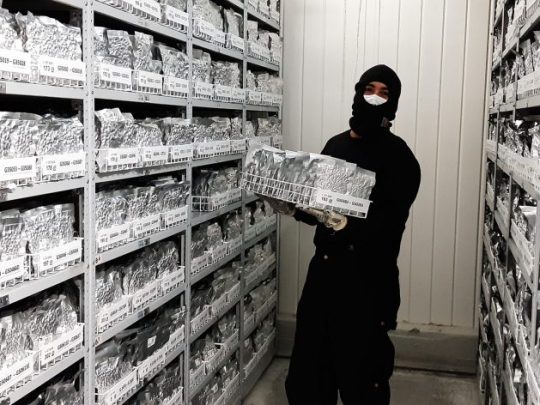
The Vault's function
Though the Vault is thought to be a "doomsday vault" that will provide seeds for the world after a global disaster, this is not the case.
"The seeds are not intended for distribution to farmers or gardeners," Fowler explained. "Their worth and utility stem from their use as a genetic resource in plant breeding. As a result, they are ultimately intended to benefit plant breeders and other scientists involved in the development of new crop varieties for farmers. Consider the seeds to be a collection of traits, or, more broadly, a collection of future options for our crops, such as disease and pest resistance, drought and heat tolerance, improved nutrition, and so on."
The Vault, and other vaults around the world, can also be used to preserve historical plant species. According to National Geographic(opens in new tab), approximately 90% of historic fruit and vegetable varieties in the United States have vanished. The seed vault will keep these seeds safe for future generations.
The Global Seed Vault, on the other hand, is intended to assist other banks.
"The seeds in the Seed Vault are duplicate copies of collections held in national and other seedbanks worldwide," Fowler explained. "If something happens to one of those facilities, and their seed samples are destroyed, a backup copy is stored in the Seed Vault. Previously, the extinction of a variety meant the extinction of that variety and any unique trait it might have contained. Today, fires, floods, natural disasters, war, human error, accidents, and funding cuts do not have to result in crop extinction. If it's in the Seed Vault, it's as secure as it can be."
Capacity
Massive amounts of seeds can be stored in the Global Seed Vault. It is designed to store 4.5 million crop varieties, with each variety containing approximately 500 seeds. According to the Global Crop Diversity Trust, an international organization that works with the Norwegian government to manage the seeds in the Vault, this equates to a maximum of 2.5 billion seeds that can be stored in the Vault. As of this writing, the Vault contains over 860,000 seed samples. Because these seeds were donated by almost every country on the planet, the Global Seed Vault contains a huge variety of seeds.
"Despite the fact that I've been working in this field for nearly 40 years, I think the biggest surprise was the breadth of diversity that came in from seedbanks all over the world," Fowler said. "I anticipated a lot of rice and wheat (we have more than 150,000 distinct varieties of each). What I didn't expect to see were seeds from so many different crops. A list of the crops represented in the Vault runs about 55 pages when printed single-spaced. Rice and wheat are divided into two lines. I admit that I had never heard of 'cheesy toes,' 'Asian pigeonwings,' or 'zombie peas,' but we have all of these and much more."
Donations and seed collection
There are some guidelines for donations and seed retrieval at the Global Seed Vault. First, they only accept donations from the Multilateral System, which is part of an international treaty on food resources or seeds that originated in the depositor's country.
The Multilateral System is a provision of the International Treaty on Plant Genetic Resources for Food and Agriculture that governs the sharing of plant genetics. According to the Food and Agriculture Organization of the United Nations, the treaty ensures that countries can freely share the genetic information of 64 crops that account for 80 percent of all human consumption through seed banks. Those who use the information and discover new information must agree to share the information or contribute a percentage of the money they earn from their research to a common fund.
2 notes
·
View notes
Text
radio.garden is my favorite way to casually listen to foreign music. its a globe of different international radio stations. my favorite is dr dick's dub shack, a station that primarily plays dub (a remix- and effect-heavy genre of reggae) from the island of bermuda
some other highlights on my personal liked stations list includes a station simply named "orthodox chants" in cheboksary russia, arctic outpost am1270 from longyearben svalbard (the same nordic island that houses thee arctic seed vault), and gaySA radio from pretoria south africa
I wish Americans fucked with more foreign music. You don’t have to know the language to appreciate a good record. Folks in other countries listen to our music and don’t speak a lick of english. Music needs no translator
224K notes
·
View notes
Text
Located in Norway’s Svalbard archipelago
There was a flood caused by melting permafrost due to climate change.
The Vault contains 1.3 million seeds and its purpose to preserve food crops in case of mass plant extinction.
1 note
·
View note
Text

Svalbard Global Seed Vault
Inside this building is 13,000 years of agricultural history. Essentially a huge safety deposit box, holding the world’s largest collection of agricultural biodiversity. Opened in 2008.
“There are big and small doomsdays going on around the world every day. Genetic material is being lost all over the globe,” says Marie Haga, executive director of the Crop Trust.

2017 - But soaring temperatures in the Arctic at the end of the world’s hottest ever recorded year led to melting and heavy rain, when light snow should have been falling. The end of 2016 saw average temperatures over 7C above normal on Spitsbergen, pushing the permafrost above melting point. A lot of water went into the start of the tunnel and then it froze to ice, so it was like a glacier when you went in. The vault was supposed to operate without the help of humans, but now must be monitored 24 hours a day. The breach has questioned the ability of the vault to survive as a lifeline for humanity if catastrophe strikes.
The vault managers are now taking precautions, including major work to waterproof the 100m-long tunnel into the mountain and digging trenches into the mountainside to channel meltwater and rain away. They have also removed electrical equipment from the tunnel that produced some heat and installed pumps in the vault itself in case of a future flood.
“We have to find solutions. It is a big responsibility and we take it very seriously. We are doing this for the world.”
“This is supposed to last for eternity,” said Åsmund Asdal at the Nordic Genetic Resource Centre, which operates the seed vault.
2024 - Daniel Brooks co-author of A Darwinian Survival Guide uses the Seed Vault as an analogy for preparing for the coming years.
"The place where it is was chosen because it was thought that it was going to be cold forever, and everything would be fine, and you could store all these seeds now. And now all the area around it is melting, and this whole thing is in jeopardy. This is a really good example of letting engineers and physicists be in charge of the construction process, rather than biologists. Biologists understand that conditions never stay the same; engineers engineer things for, this is the way things are, this is the way things are always going to be. Physicists are always looking for some sort of general law of in perpetuity, and biologists are never under any illusions about this. Biologists understand that things are always going to change."
Me: I'm digesting information and I don't quite know yet how to talk about my thought feelings. Change to our biosphere is rolling in faster than these intelligent people thought it would. Wildfire in the Arctic circle! Extreme weather. Ice melt. Social instability.
source: Time source: Guardian source: MIT Press Reader
1 note
·
View note
Text
The Arctic Seed Vault Shows the Flawed Logic of Climate Adaptation | Scientific American
0 notes